Addiction treatment medications: how they help, benefits, and common medications
Table of content
- What are addiction treatment medications?
- How do medications help with addiction treatment?
- What are the benefits of taking addiction treatment medications?
- What are the common addiction treatment medications?
- How effective are medications for addiction treatment?
- Is therapy required alongside addiction treatment medications?
- Are medications for addiction treatment dangerous?
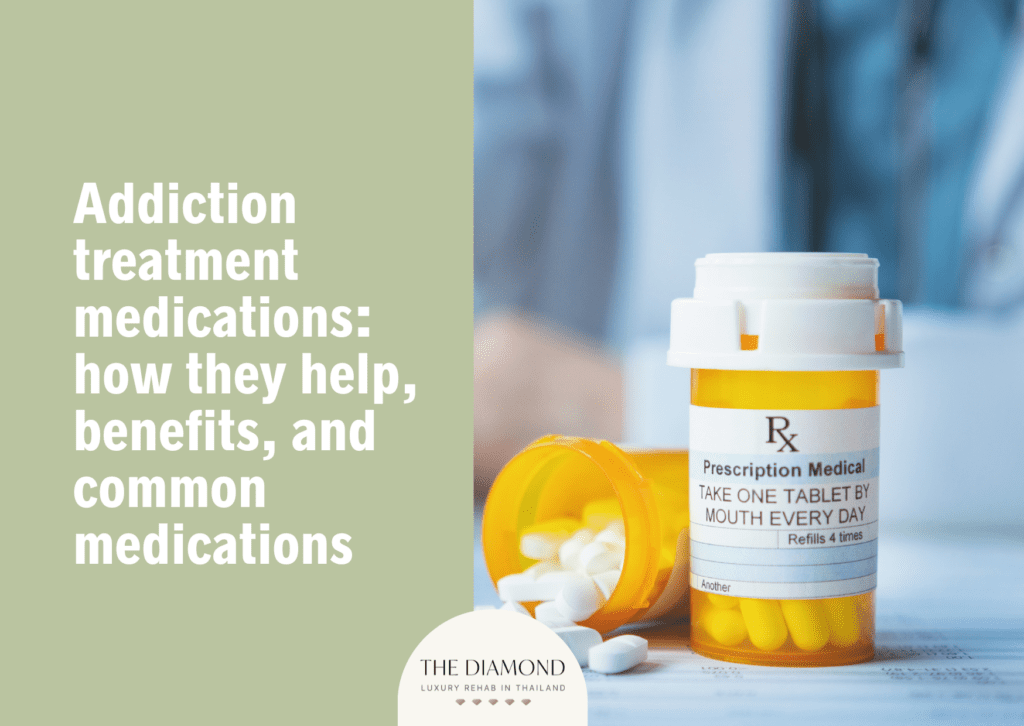
Addiction treatment medications are pharmaceutical drugs used in managing withdrawal symptoms, lower cravings, or treat co-occurring mental health issues related with drug use disorders.
Medications help with addiction treatment by reversing normal brain chemistry after substance usage has changed it. Addictive drugs frequently disrupt the reward system in the brain since they raise dopamine levels, producing a false sensation of pleasure.
The benefits of taking addiction treatment medications include the alleviation of withdrawal symptoms, reduction of cravings, improvement of brain chemistry, and support of behavioral therapy.
Common addiction treatment medications include acamprosate (Campral), disulfiram, gabapentin, naltrexone, topiramate (Topamax), methadone, buprenorphine, Sublocade, Narcan (naloxone), Subutex, Suboxone, Vivitrol, Klonopin, bupropion, baclofen, clonidine, and buspirone.
What are addiction treatment medications?
Addiction treatment medications are specialized drugs that help people deal with the mental and physical difficulties associated with overcoming substance abuse. Through assisting in the stabilization of brain chemistry and facilitating the shift to behavioral therapies and sustained abstinence, pharmacological treatments for drug addiction aid in recovery.
According to a 2013 article by Douaihy et al., titled, “Medications for Substance Use Disorders,” medication is used in conjunction with psychosocial therapy for substance use disorders in order to manage withdrawal, lessen cravings, and avoid relapse. There are three types of drugs used: antagonists (like naltrexone), partial agonists (like buprenorphine), and full agonists (like methadone).
Frequently adapted to target certain addictions, they deal with substances like alcohol, nicotine, or opioids. Pharmaceuticals, when integrated with counseling or behavioral therapies, augment the efficacy of addiction treatment and encourage sustained addiction recovery by reducing relapse risks and fostering healthier coping strategies.
How do medications help with addiction treatment?
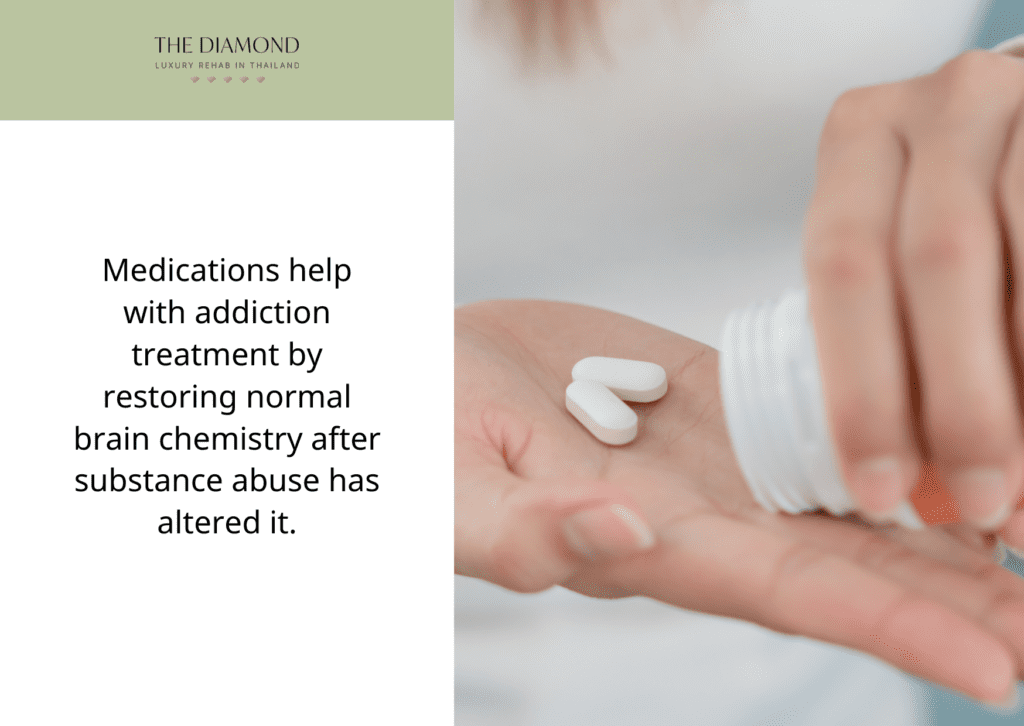
Medications help with addiction treatment by restoring normal brain chemistry after substance abuse has altered it. The brain’s reward system is frequently altered by addictive substances, which induce an artificial sense of pleasure by increasing the release of dopamine.
Over time, the brain adapts, reducing its natural dopamine production and making it dependent on the substance to function normally. Addiction treatment medications help restore balance by either mimicking the effects of the substance in a controlled way or blocking its impact, reducing cravings and withdrawal symptoms.
How do addiction treatment medications help with withdrawal?
Addiction treatment medications help with withdrawal by interfering with the chemical processes in the brain to lessen the psychological and physical harm brought on by substance abuse. Medications meant for opioid addiction, for instance, target opioid receptors in the brain, which control pleasure and pain.
Such drugs either partially activate the receptors to ease withdrawal symptoms without producing the intense euphoria associated with opioids or block the receptors to prevent the effects of the substance altogether.
Through minimizing discomfort and stabilizing the body’s response, medications make the drug withdrawal phase more manageable, enabling individuals to transition into the recovery process with greater focus and stability.
How do addiction treatment medications help with detox?
Addiction treatment medications help with detox by helping former users deal with the difficulties arising when the body gets rid of harmful substances. Detox medications are designed to ease withdrawal symptoms, support bodily stability, and rebalance brain function disrupted by addiction.
Drug detox is frequently a difficult stage since the body finds it difficult to cope with the absence of the addictive substance, frequently resulting in withdrawal symptoms like strong cravings, anxiety, and nausea.
Detox drugs, including methadone or buprenorphine for opioid dependence, help stabilize the brain by interacting with the same opioid receptors the substance targeted, but in a controlled and less harmful way.
The detoxification process is rendered less intimidating with the administration of medications intended for addiction treatment, facilitating enduring recovery alongside behavioral therapy and prolonged care.
What are the benefits of taking addiction treatment medications?
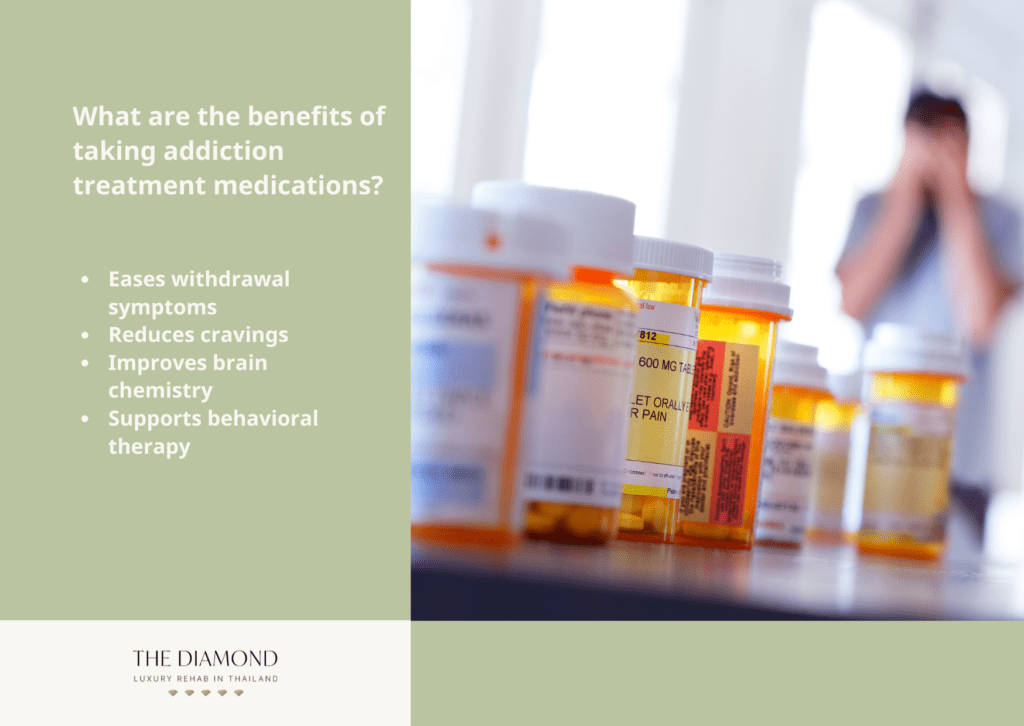
Benefits of taking addiction treatment medications relate to the advantages individuals experience when using prescribed drugs to support recovery from substance dependence. The benefits of taking addiction treatment medications are listed below.
- Eases withdrawal symptoms: Addiction treatment medications help manage the discomfort that occurs when the body adjusts to the absence of a substance. These drugs work by calming the nervous system or mimicking the effects of illicit drugs in a controlled way, making withdrawal less painful. Through alleviating symptoms like nausea, anxiety, or seizures, individuals are able to better focus on recovery efforts. Effective withdrawal management reduces the risk of returning to substance use during this critical phase.
- Reduces cravings: Specific medicines work to lessen cravings, a major factor driving substance use. Such treatments stabilize the brain’s reward system, decreasing the urge to consume substances such as alcohol or opioids. A reduction in cravings improves the chances of engaging with treatment services and sustaining recovery. Environmental signals and stress are major causes of craving and relapse, and pharmaceutical treatments have been investigated to lessen such effects, as per a 2014 study by Haass-Koffler et al., titled, “Pharmacological Approaches to Reducing Craving in Patients with Alcohol Use Disorders.”
- Improves brain chemistry: Long-term substance use, including prescription drug addiction, disrupts the brain’s natural chemical balance. Every drug of abuse raises dopamine levels in the reward systems of the brain, encouraging drug-seeking behavior. Chronic drug use eventually reduces interest in non-drug activities by weakening dopamine responses to natural rewards, according to a 2019 paper by Volkow et al., titled, “The Neuroscience of Drug Reward and Addiction.” Medicines for addiction improve brain chemistry by restoring balance to formerly disrupted neurotransmitter activity. Retraining neural pathways with treatments aimed at specific brain receptors makes it easier to break patterns of dependence and recover control of decision-making.
- Supports behavioral therapy: Medicines provide stability, allowing individuals to concentrate more effectively on therapy addressing the root causes of addiction. A stable mental and physical state fosters active participation in developing healthier coping strategies. Enhanced focus during therapy increases the likelihood of sustained recovery. The combination of therapy and medication allows individuals to focus on rebuilding their lives without the constant pull toward using drugs.
What are the common addiction treatment medications?
Common addiction treatment medications are drugs often employed to support people’s recovery process and help with overcoming drug dependency. The most common addiction treatment medications are detailed in the table below.
| Common Addiction Treatment Medications | ||||||
| Medication | Mechanism of Action | Condition Treated | Effects | Common Side Effects | Administration Method | Prescription Requirements |
| Acamprosate (Campral) | Modulates glutamate activity to reduce alcohol withdrawal symptoms | Alcohol use disorder | Reduces cravings and stabilizes mood | Dizziness, diarrhea, fatigue | Oral (tablet) | Requires a prescription from a licensed provider |
| Disulfiram | Inhibits acetaldehyde metabolism, causing unpleasant reactions when alcohol is consumed. | Alcohol addiction | Prevents relapse by deterring drinking | Nausea, vomiting, drowsiness | Oral (tablet) | Requires close monitoring and prescription |
| Gabapentin | Controls calcium channels to lower nervous system excitability | Alcohol or opioid dependence | Provides relief for withdrawal symptoms | Drowsiness, fatigue, dizziness | Oral (tablet/capsule) | Requires a doctor’s prescription |
| Naltrexone | Blocks opioid receptors, reducing cravings and the effects of alcohol/opioids | Alcohol and opioid addiction | Reduces cravings for substances | Nausea, abdominal pain, loss of appetite | Oral (tablet) or monthly injections | Prescription required, monitoring advised |
| Topiramate (Topamax) | Modulates neurotransmitters to reduce cravings | Alcohol and stimulant use disorders | Reduces cravings and relapse risk | Cognitive issues, weight loss, fatigue | Oral (tablet/capsule) | Prescription required |
| Methadone | Activates opioid receptors to prevent withdrawal | Opioid addiction | Provides relief from withdrawal symptoms | Constipation, drowsiness, respiratory issues | Oral (liquid, tablet) | Strictly regulated; prescribed through licensed opioid treatment programs |
| Buprenorphine | Partially activates opioid receptors to reduce cravings and withdrawal symptoms | Opioid addiction | Eases cravings without euphoria | Headache, nausea, sweating | Sublingual (tablet/film) | Prescription required, authorized providers only |
| Sublocade | Extended-release injection of buprenorphine | Opioid use disorder | Long-lasting relief for withdrawal symptoms | Injection site reactions, headache | Monthly subcutaneous injection | Prescription required, specialized distribution |
| Narcan (Naloxone) | Rapidly reverses opioid overdose by blocking receptors | Opioid overdose | Reverses life-threatening symptoms | Nausea, fever, sweating | Nasal spray or injection | Available without a prescription in certain regions |
| Subutex | Contains buprenorphine to reduce opioid cravings | Opioid addiction | Stabilizes recovery and reduces cravings | Nausea, headache, insomnia | Sublingual (tablet/film) | Prescription required; Subutex is monitored closely |
| Suboxone | Combines buprenorphine and naloxone to prevent misuse | Opioid addiction | Reduces cravings and deters misuse | Mouth numbness, nausea, insomnia | Sublingual (tablet/film) | Prescribed by certified healthcare providers |
| Vivitrol | Extended-release injectable naltrexone | Alcohol and opioid addiction | Provides sustained relief from cravings | Injection site pain, nausea, dizziness | Monthly intramuscular injection | Prescription required, adherence monitoring advised |
| Klonopin | Contains clonazepam and serves as a benzodiazepine used to ease withdrawal symptoms in individuals recovering from benzodiazepine addiction | Benzodiazepine addiction | Manages withdrawal symptoms | Drowsiness, dizziness, memory issues | Oral (tablet) | Prescription required, tapering recommended |
| Bupropion | Modulates norepinephrine and dopamine levels | Stimulant addiction | Reduces cravings for stimulants | Dry mouth, insomnia, agitation | Oral (tablet) | Prescription required |
| Baclofen | Relaxes muscles and reduces withdrawal tension | Alcohol use disorder | Promotes calmness during detox | Drowsiness, dizziness, nausea | Oral (tablet) | Prescription required |
| Clonidine | Lowers stress by calming the nervous system | Opioid and alcohol addiction | Alleviates unpleasant withdrawal symptoms | Low blood pressure, fatigue, dry mouth | Oral (tablet/patch) | Requires a prescription |
| Buspirone | Partially activates 5-HT1A serotonin receptors while blocking dopamine D2, D3, and D4 receptors, helping regulate serotonin and dopamine activity to reduce anxiety and cravings | Alcohol and stimulant addiction | Reduces anxiety-related cravings | Dizziness, headache, nausea | Oral (tablet) | Prescribed by healthcare professionals |
Through tailoring support for substance use disorders, addiction treatment medications handle complex recovery hurdles. Anti-addiction drugs are more likely to result in an ongoing recovery when combined with therapy.
How effective are medications for addiction treatment?
Medications for addiction treatment are highly effective, especially when combined with behavioral therapies. The use of medication to treat substance use disorders (SUD) helps manage cravings, reduce withdrawal symptoms, and stabilize brain function—all crucial steps in the recovery process.
Diverse patterns of substance use, concomitant disorders, and personal strengths/resources are exhibited by individuals with SUDs. The integration of pharmacological and behavioral therapies improves overall treatment effectiveness, especially in complex situations with co-occurring illnesses, as per a 2003 review by Mark P. McGovern and Kathleen M. Carroll titled, “Evidence-based practices for substance use disorders.”
Since effective addiction treatment must address the psychological as well as the physical components of addiction, medications are a crucial part in improving results and lowering the chance of relapse. The prevalence of co-occurring disorders, the availability of extensive support networks, and the patient’s dedication to recovery are additional factors affecting how well a treatment works.
Is therapy required alongside addiction treatment medications?
Yes, therapy is required alongside addiction treatment medications in order to achieve a more thorough and successful recovery. The underlying psychological and behavioral components of addiction are the focus of therapy and counseling, whilst drugs serve to stabilize brain function and treat physical symptoms.
Therapies like cognitive behavioral therapy (CBT), motivational interviewing, and contingency management help individuals identify and modify unhealthy patterns of thought and behavior related to substance use.
Dealing with emotional difficulties, developing better coping mechanisms, and strengthening relationships are all ways wherein counseling offers vital support. Together, medication and therapy are a complete method for dealing with both the physical and mental aspects of addiction, greatly increasing the chances of long-term recovery.
Do you need to go to medication-assisted treatment to get addiction medications?
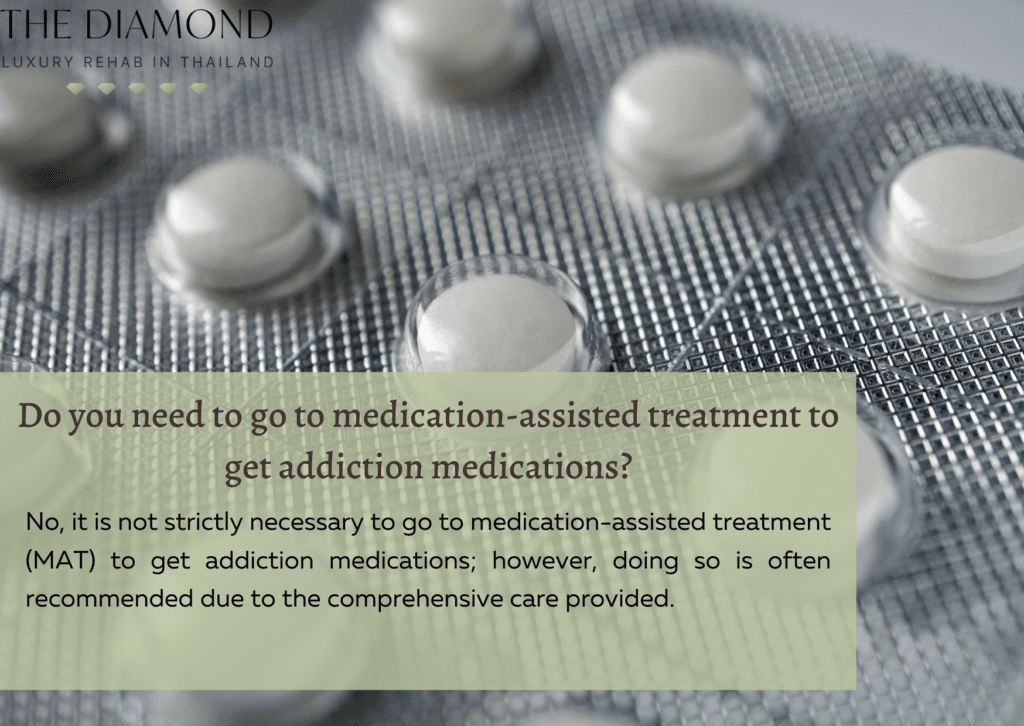
No, it is not strictly necessary to go to medication-assisted treatment (MAT) to get addiction medications; however, doing so is often recommended due to the comprehensive care provided.
MAT employs a whole-patient approach, combining FDA (United States Food and Drug Administration)-approved medications with counseling and behavioral therapies to address the multifaceted nature of substance use disorders.
However, according to a publication from the Illinois Department of Public Health titled, “Medication-Assisted Treatment FAQ,” MAT is still not often utilized, even though decades of clinical study have demonstrated its effectiveness in treating opioid use disorder (OUD).
Only one-third of patients with opioid dependence in privately sponsored substance use disorder treatment programs actually receive MAT, and less than half of facilities offering treatment include the program. MAT is not available to all OUD patients who require treatment in almost all U.S. states due to a lack of treatment capacity.
Medication-assisted treatment not just helps normalize brain chemistry and reduce cravings but equips individuals with essential coping mechanisms and support systems as well. While certain medications, such as buprenorphine, are prescribed by qualified healthcare providers outside of specialized MAT programs, engaging in a comprehensive treatment plan combining both medication and therapy addresses the root causes of addiction and reduces the risk of substituting one dependency for another.
Addiction medications prescribed through MAT programs are carefully managed to ensure patients do not get addicted to the treatment itself, promoting safe and sustainable recovery.
Are medications for addiction treatment dangerous?
No, medications for addiction treatment are not inherently dangerous when used as prescribed and under proper medical supervision. Addiction medicines, such as methadone, buprenorphine, and naltrexone, are rigorously tested for safety and effectiveness and are FDA-approved to treat substance use disorders.
Although side effects including constipation, nausea, or dizziness are common, the beneficial effects of lowering cravings, preventing relapse, and helping recovery usually outweigh risks. Misuse or unsupervised use of the medications does, however, carry concerns including dependence or adverse reactions.
For this reason, they are usually prescribed as part of an all-encompassing therapy program that incorporates counseling, behavioral therapies, and medical supervision to guarantee proper utilization.
Can medications for addiction treatment lead to another addiction?
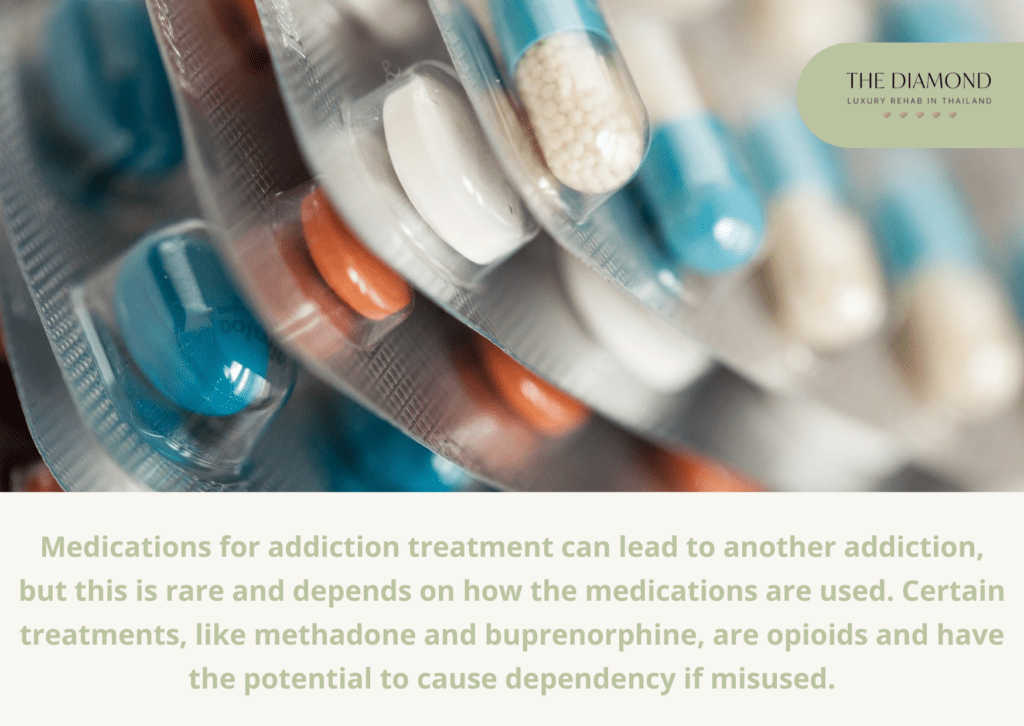
Yes, medications for addiction treatment can lead to another addiction, but this is rare and depends on how the medications are used. Certain treatments, like methadone and buprenorphine, are opioids and have the potential to cause dependency if misused.
However, when these medications are taken as prescribed under medical supervision, the risk of becoming addicted to medicines is minimal. Substance abuse medications work by regulating brain chemistry and decreasing the urge to seek out and use other drugs.
The controlled dosages and the therapeutic environment in which they are administered further reduce the likelihood of misuse.


